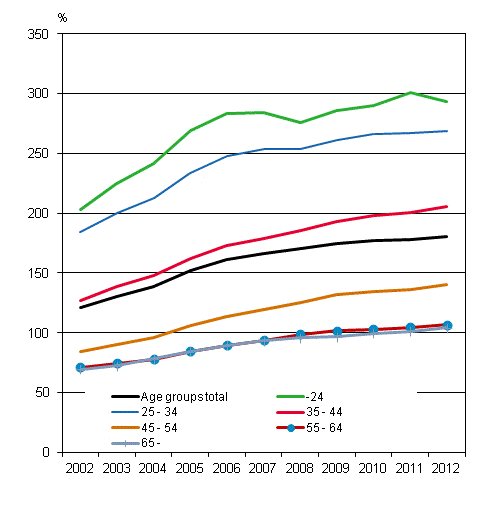Published: 23 January 2014
Housing loans grew by 4.7 per cent in 2012
Statistics Finland’s statistics on indebtedness show that the average size of housing loan per house-hold-dwelling unit with a housing loan was 180 per cent of the annual income in 2012. Apart from persons aged under 25, the share of housing loans of the income grew for household-dwelling units of all ages. In nominal terms, the income of household-dwelling units with housing loans grew by 3.2 per cent and housing loans by 4.7 per cent from the year before.
Share of housing loans in household-dwelling units' income in 2002 to 2012

There were 869,800 household-dwelling units with housing loans in 2012. The average housing loan was EUR 92,370. Household-dwelling units in the 25 to 34 age group had the largest housing loans, amounting to EUR 122,180 per household-dwelling unit with a housing loan. In proportion to income, the largest housing loans were found in the household-dwelling units under the age of 25, nearly three times the size of their annual income.
There were 1,393,700 indebted household-dwelling units, that is, 54 per cent of all household-dwelling units. Their total debt amounted to EUR 108.7 billion. The amount of debt per indebted household-dwelling unit was EUR 77,990. Of household dwelling-units' debts, EUR 80.3 billion or 74 per cent were housing loans. Household-dwelling units' other debts, such as loans for cars, free-time residences or general consumption, amounted to EUR 20.8 billion, debt for business purposes to EUR 6.0 billion and study loans to EUR 1.6 billion. 1)
The number of household-dwelling units whose debts were at least triple compared with disposable annual income was 263,200, making up ten per cent of all household-dwelling units. In 2002, 97,370 household-dwelling units were this much in debt, that is, around four per cent of household-dwelling units. Household-dwelling units where the reference person was aged 25 to 34 were generally the most indebted. Of the household-dwelling units in this age group, nearly one-quarter, i.e. 94,500, had debts that were at least triple compared with their annual income. Five per cent of indebted household-dwelling units, i.e. 63,580, had debts that were at least five times as high as their annual income.
During a decade, household-dwelling units' debts have gone up clearly faster than their income. From 2002 to 2012, household-dwelling units' debts doubled in real terms, while their disposable monetary income grew by 27 per cent over the same period. During this period, housing loans grew the most, by 130 per cent. In 2002, housing loans accounted for 65 per cent of all household-dwelling units' debts, while in 2012 their respective share was already 74 per cent.
In 2012, household-dwelling units paid EUR 2.5 billion in interests, of which EUR 1.7 billion were interests on housing loans. Average interest expenses per indebted household-dwelling unit were EUR 1,820. Forty six per cent of indebted household-dwelling units paid at most EUR 1,000 in interests and seven per cent over EUR 5,000.
1) Other debts are not comparable with previous years for 2012 because the Tax Administration changed its guidelines on their reporting.
Source: Indebtedness 2012. Statistics Finland
Inquiries: Timo Matala 09 1734 3422
Director in charge: Riitta Harala
- Tables
-
Tables in databases
Pick the data you need into tables, view the data as graphs, or download the data for your use.
Updated 23.1.2014
Official Statistics of Finland (OSF):
Indebtedness [e-publication].
ISSN=2489-3285. 2012. Helsinki: Statistics Finland [referred: 9.1.2026].
Access method: http://stat.fi/til/velk/2012/velk_2012_2014-01-23_tie_002_en.html

